Injeolmi is a popular Korean rice cake that’s perfectly soft, chewy, nutty and mildly sweet. Make this wonderful gluten-free and vegan treat at home (with just the microwave) in less than 10 minutes!
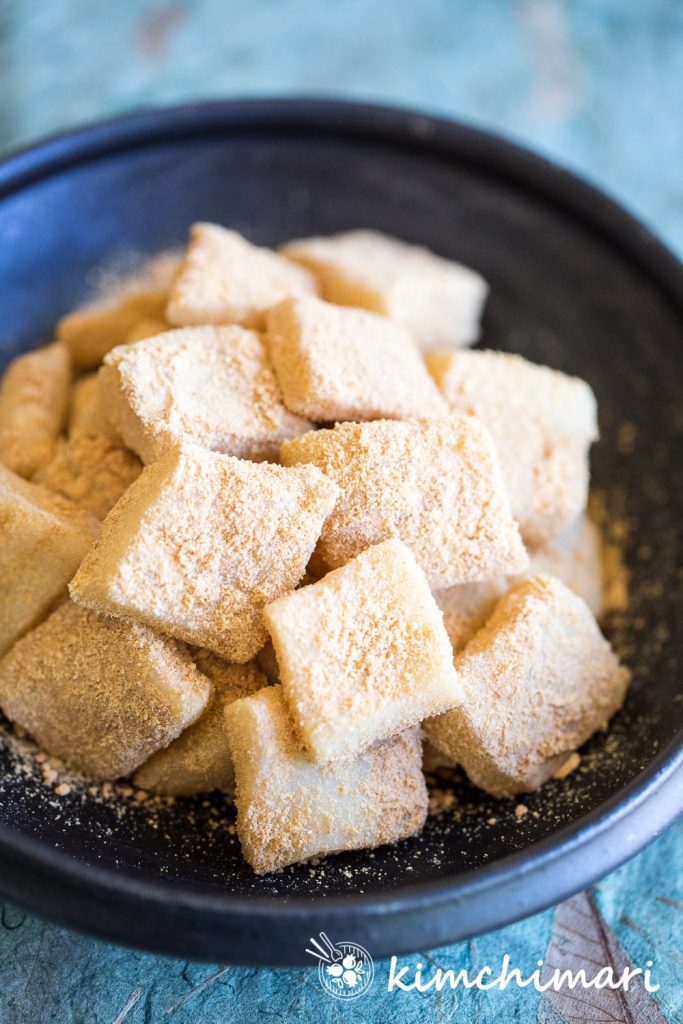
What is Injeolmi?
Injeolmi 인절미 is a type of Korean rice cake made with glutinous rice. Traditionally, sweet sticky rice is steamed, then pounded until it becomes a nice blob 😝 with a chewy texture which we call Tteok 떡. This method of making tteok normally takes hours when you include hours of soaking the sweet rice, then steaming and then pounding.
The tteok is then cut into smaller pieces and often coated with either roasted soybean powder 볶은 콩가루 Bokkeun Kongaru, ground black sesame seeds or cooked (unsweetened) Azuki red beans (단팥 dan-paat). This rice cake is also eaten without any coating but just by itself, dipped in honey or sugar.
Note, there are 2 different categories of Korean Tteok based on what kind of rice is used. Chapssal Tteok (찹쌀떡) are rice cakes that are made using glutinous/sweet/sticky rice, this includes tteok like Hwajeon 화전, Bukkumi 부꾸미, Kyeongdan 경단, and of course Injeolmi. Maepssal Tteok (멥쌀떡) are made using regular short-grain rice and some common ones are Songpyeon 송편, Sirutteok 시루떡, Hobaktteok 호박떡, Danja 단자, Sultteok 술떡 and more.
So one thing about this tteok — I grew up hearing the adults talk about how Injeolmi was easy to digest and was really good for the stomach. I half believed it when I was little because I was thinking in my head – it’s this blob of a thing that’s even kind of hard to chew and sometimes it can even get stuck on the way down to your stomach. How can this be easy to digest? lol…
But as it always turns out, the wisdom of our ancestors is never to be ignored. My sister #3 always struggled with an acidic stomach and her father-in-law (who is a family physician) told her to just eat Injeolmi every morning instead of taking antacid medications. So she ate it for a year for breakfast every morning and she swears that it helped her heal fully from it.
IMPORTANT NOTE – I am by no means suggesting that Injeolmi is a full remedy for your acidic stomach condition. PLEASE consult a doctor first to find the cause of your symptoms and the appropriate treatment. I shared the story more as a piece of cultural information and personal experience. And more as a food that could help your condition (just like bland food is better than spicy foods) but by no means a cure.
I’ve also personally found tteok to help with my acid stomach so I know there’s something there but I haven’t been able to stick it with it long enough to see my condition go away. BTW, my acid condition is not really bad that I need to take medication because it comes and goes. No acid reflux or anything like that. Everyone’s condition is different so please consult your Dr.
I did a quick search and interestingly, there’s research done by Korean scientists that conclude “Our results suggest that glutinous rice proteins are useful for the prevention and treatment of gastritis and peptic ulcer.” But somehow other than that, I could not find other scientific evidence so it’s up to you. Maybe because only a small section of the world population eats sweet rice..?
Chef’s Tips
- Follow instructions in order and closely – Injeolmi dries up pretty quickly and it’s only nice and stretchy when it’s still hot so you have only a narrow window of time to spread it out, coat and cut.
- Whole sweet rice grain vs flour – traditionally, sweet rice is soaked, steamed then pounded. I’ve tried grinding the sweet rice at home and then tried making with it. But because I can’t pound it fully, it just didn’t give as good results as using flour. Best results are produced with commercial finely ground sweet rice flour or Mochiko flour.
- Other flavors/coating – ground black sesame seeds (Heukmija 흑임자) or cooked azuki red beans (Paat 팥) can also be used. Note, cooked azuki red beans (not sweet bean paste but the actual beans just cooked in water and ground) spoil easily in summer so make this only in cool seasons.
- Storage – Store at cool room temperature, tightly covered for up to 12 hrs or less. Best to freeze in airtight container or bag to maintain freshness.
- Reheating/Thawing – Frozen Injeomi is best thawed at room temperature. Alternatively, reheat in a non-stick pan at medium-low heat for a couple of minutes on each side. For softer and moist results, sprinkle some water when the pan is hot (with rice cake in it) and cover with a lid for a couple of minutes. You can also leave it in a warm rice cooker for a few minutes. My least favorite option is to reheat in the microwave – a lot of times, it will reheat unevenly and tteok will become really hard once it cools so use the microwave if you know that you will eat all in one sitting.
How to make Injeolmi
Servings: 4 Cooking Time: 10 minutes Difficulty: Medium
What you need: Sweet Rice Flour, Sugar, Salt, Water and Roasted Soybean Powder
Directions
- Divide soybean powder into roughly two portions. On a sheet pan or a brownie pan, coat the bottom of the pan by spreading half of the roasted soybean flour. I spread about 9×7 inch area of my 9×13 brownie pan for one batch of the recipe (2 cups flour). You can also do it in a 8×8 pan.
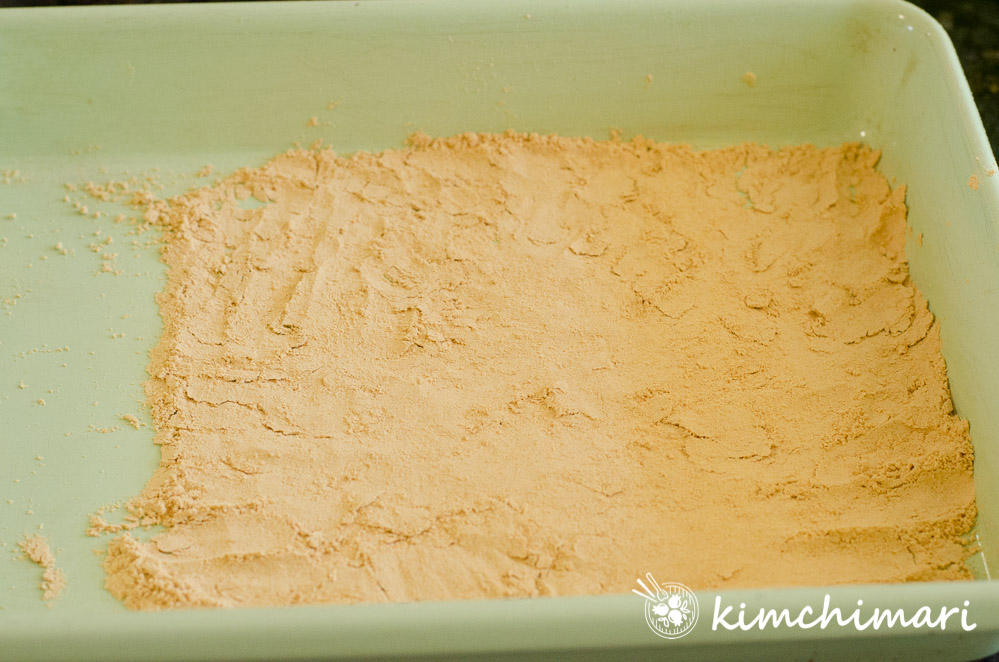
Soybean powder (콩가루 Konggaru) - Sprinkle about 1/2 to 1and tsp of sugar and a light sprinkle of salt (1/4 tsp) on top of the soybean flour. Set aside.

Sugar and salt sprinkled soybean powder - In a microwavable bowl, add sweet rice flour (aka mochiko flour), salt and sugar. Mix with a whisk.
- Add water to flour mixture and mix with a spatula until everything is well blended and no dry flour exists. Be sure to scrape the bottom of the bowl to mix in all the flour. Even and smooth out the top with a spatula and cover with a plastic wrap.
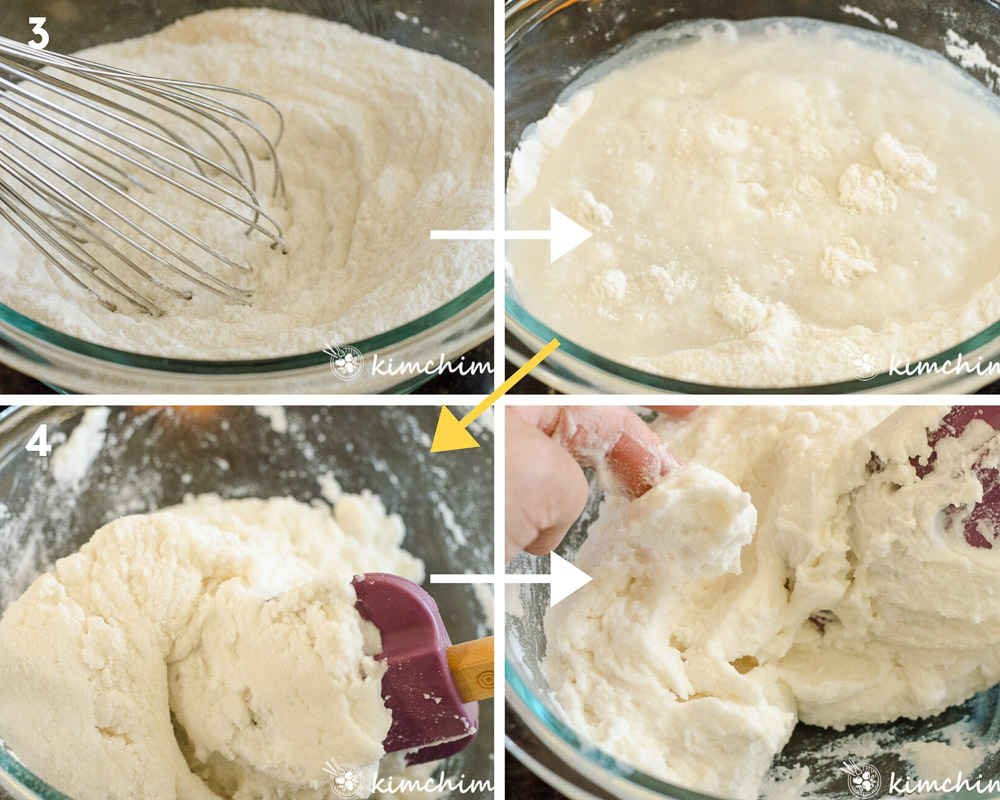
Making Dough for Injeolmi - Put the covered bowl in the microwave and cook on HIGH for 2 minutes. The first pic is how it looks after 2 min – it’s all puffed up!
- Take out the bowl from the microwave, uncover the wrap (be careful of the hot steam as you uncover). You will see that only the top layer is cooked. Using a spatula, mix it so that the cooked top layer goes to the bottom and the uncooked bottom layer comes to the top. Smooth out the top, cover with a plastic wrap once again.
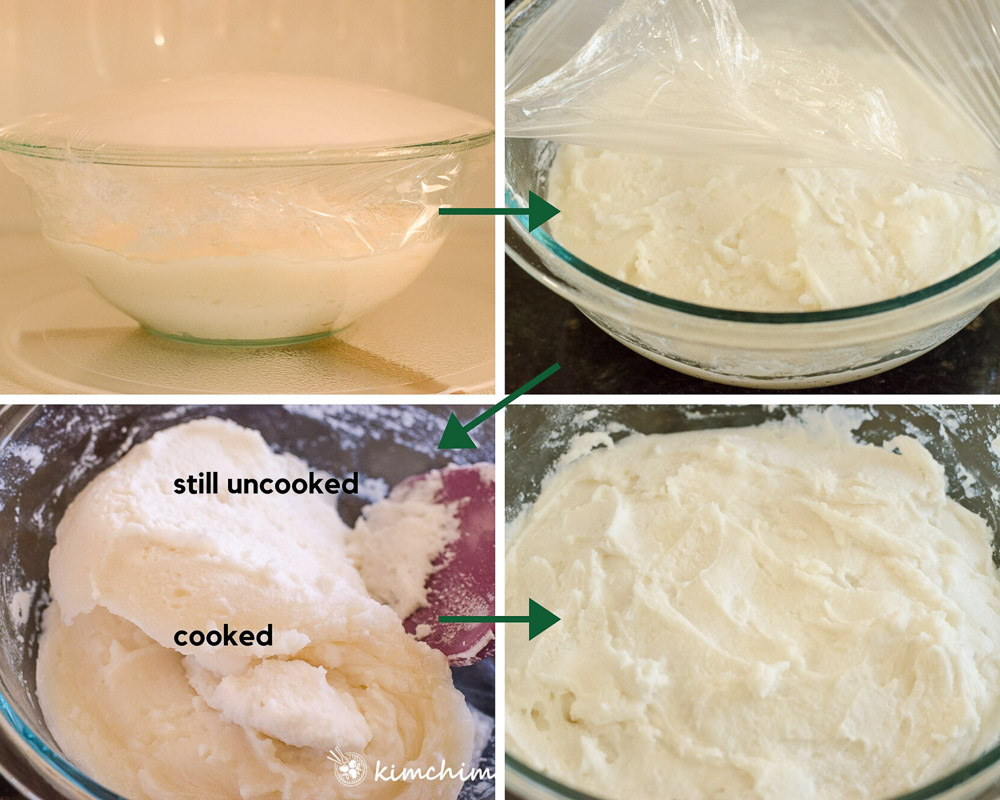
How to mix Inejolmi Dough after cooking in Microwave - Microwave HIGH for 2 minutes again. Uncover, mix (repeat step 6 above) and cover with wrap one last time.
- Now, microwave HIGH for just 1 minute.
- Take out the bowl from the microwave, uncover the wrap and dip the spatula in cold water and mix/knead the dough. Mix/knead for 30 seconds while dipping the spatula in water a 4-5 more times. This helps the rice cake not stick to the spatula too much and also cools down the tteok a little bit while adding moisture. Alternatively, you can use a stand mixer using the dough hook to knead the Injeolmi dough. 10 seconds should be enough. Sprinkle about 2 tsp of water while you knead it. This is how nice and stretchy it looks after I hand mixed it.
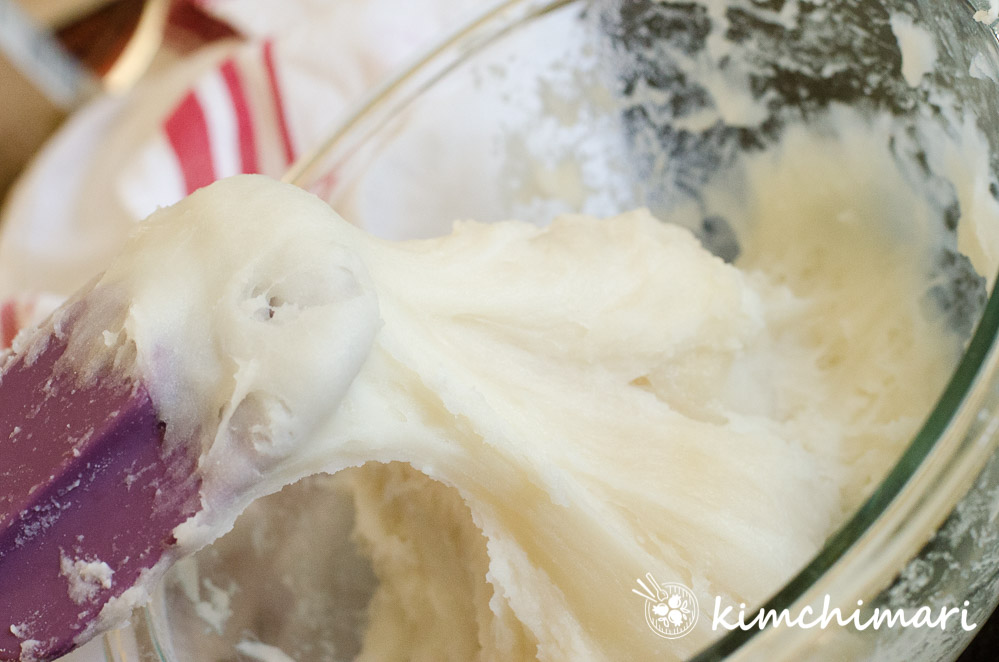
sticky rice cake finished - Have the soybean flour sheet pan and bowl of cold water ready next to the rice cake. Put disposable plastic gloves on. The plastic gloves are not a must but it just makes things easier (not have your hand all covered in tteok).
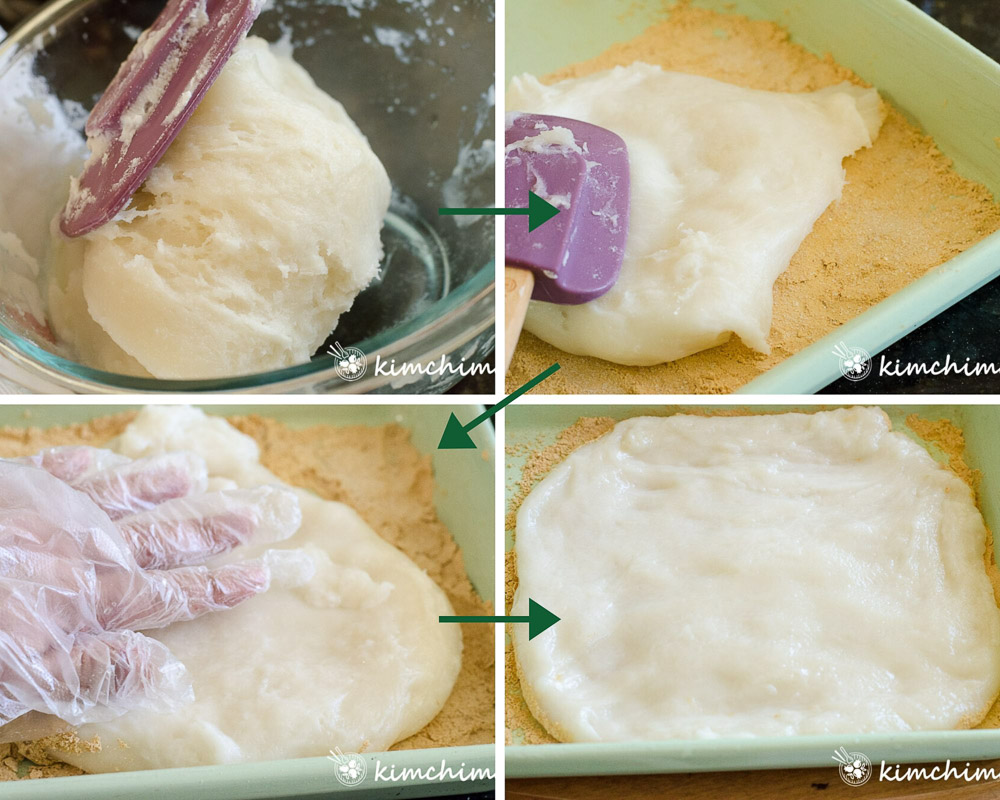
Spreading out Injeolmi Form the Injeolmi rice cake into one ball using a spatula (because it will still be too hot for your hands) and transfer it over to the center of the sheet pan. Now, wet your plastic gloves with cold water and quickly press down the rice cake to spread it out evenly. Repeat wetting your gloves if you feel it’s too hot or it’s sticking. Press and spread until it covers most of the soybean powder area or until you get your desired thickness – about 1/2 inch at least or thicker. WATCH VIDEO below to see how I do this.
- As soon as you are done spreading it out, cover the top with more soybean powder. Using scissors, cut rice cake into long strips and then each strip into smaller squares or rectangles. For each cut piece, cover the cut sides with soybean flour so it’s fully covered all around. The soybean powder prevents Injeolmi from drying out and adds a wonderful nutty flavor.
- NOTE – if the top dries out before you cover it with the soybean powder, the powder may not stick to the tteok. If this happens, just lightly wet the top with water and then the powder will now stick.
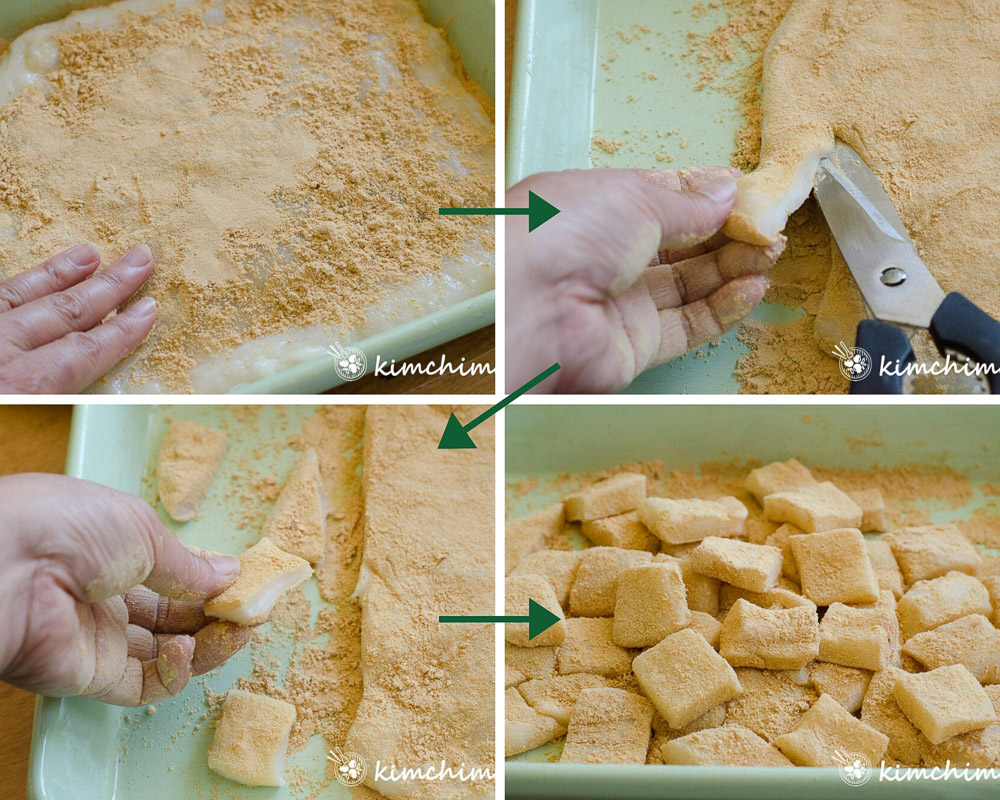
Coating Rice Cake with Soybean Powder (Konggaru) and Cutting into sqaures
- NOTE – if the top dries out before you cover it with the soybean powder, the powder may not stick to the tteok. If this happens, just lightly wet the top with water and then the powder will now stick.
- Enjoy with some lovely tea ☕️ and honey 🍯 for dipping!
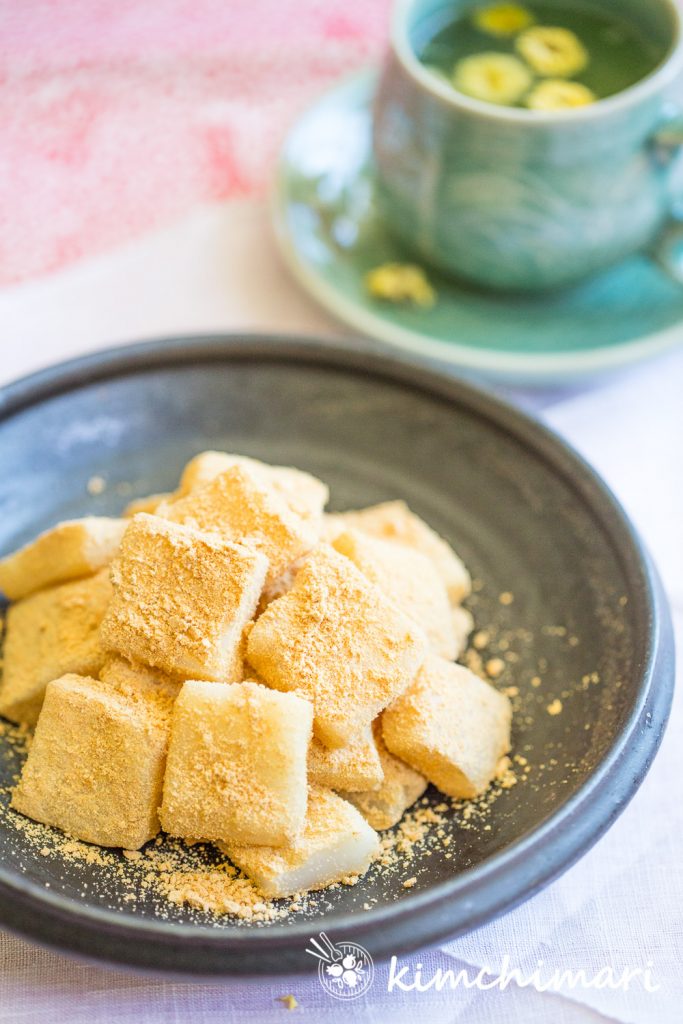
And here are some close-up shots – this recipe really yields just as good results like the ones you buy from the store. So, really, there’s no need to buy it from the store anymore!
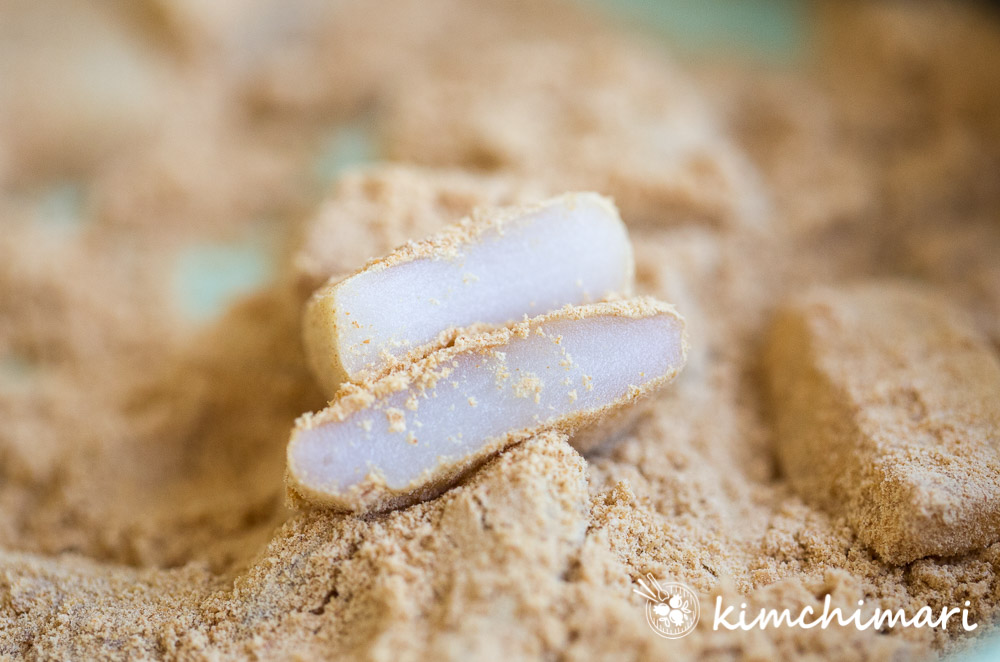

FAQ
What is Roasted Soybean Powder (Bokkeun Kongaru 볶은 콩가루) and where to buy
Bokkeun Kongaru is made by roasting whole dry soybeans then grinding them into powder. This ingredient is common in both Korean and Japanese recipes and you can use them interchangeably. Below are 2 commonly available packages (the left is Assi brand and the right one is Japanese Shirakiku Kinako) that you will probably see at your local Asian grocery store or online. I’ve added them to my Amazon store so you can buy them there too.
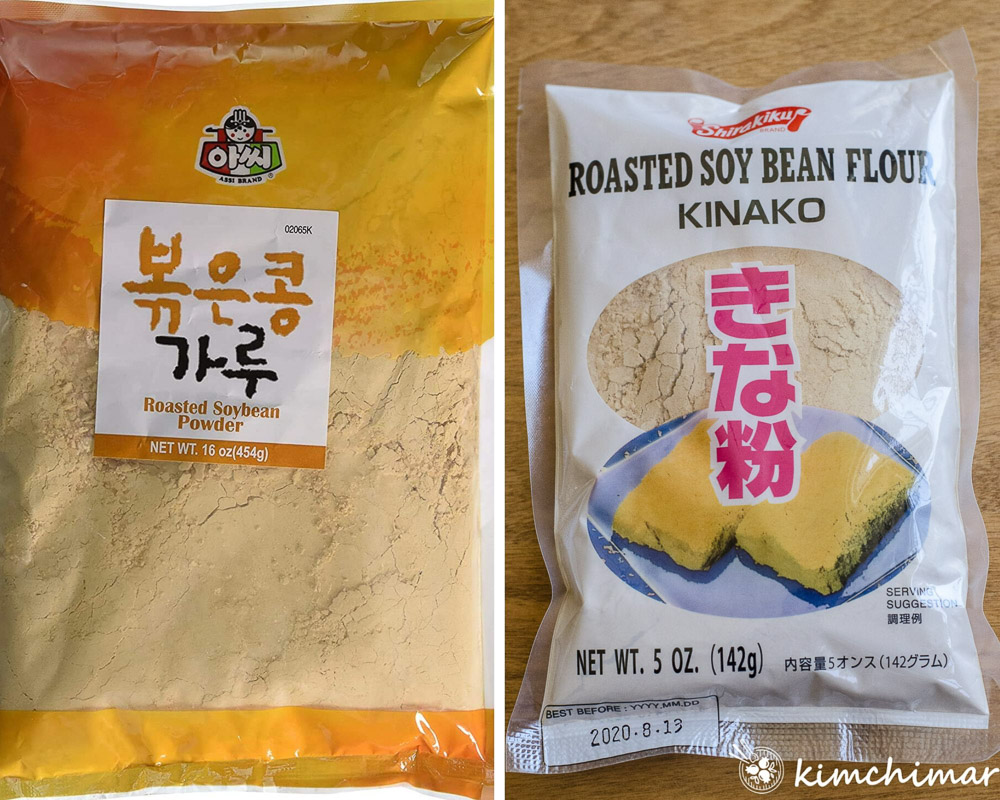
Can I make my own roasted soybean powder?
Yes, you can. The recipe is to soak the dry soybeans for 30 min or so, then drain and cook and roast in a frying pan. Once it’s roasted, you need to grind it to a fine powder. The issue is most of our blenders or choppers are really not powerful or have a way to make such a fine powder.
Don’t I need to pound it or knead longer for authentic chewy Injeolmi?
My recipe says to only knead or mix it for 30 seconds or so but I know some recipes will say to knead it longer. I have tested the recipe by kneading with a stand mixer for a few minutes (which would be much longer by hand) versus just hand mixing for around 30 seconds. And I have to say, I really did NOT see any difference in the texture. But it’s up to you. You can certainly knead it longer – no harm in doing that.
Other recipes using Sweet Rice Flour
Now, guess what?!! You can now make Injeolmi Toast even if you can’t buy it from a store. I know NOT everyone could buy the rice cake to make this sandwich before. But now you can make it yourself!!
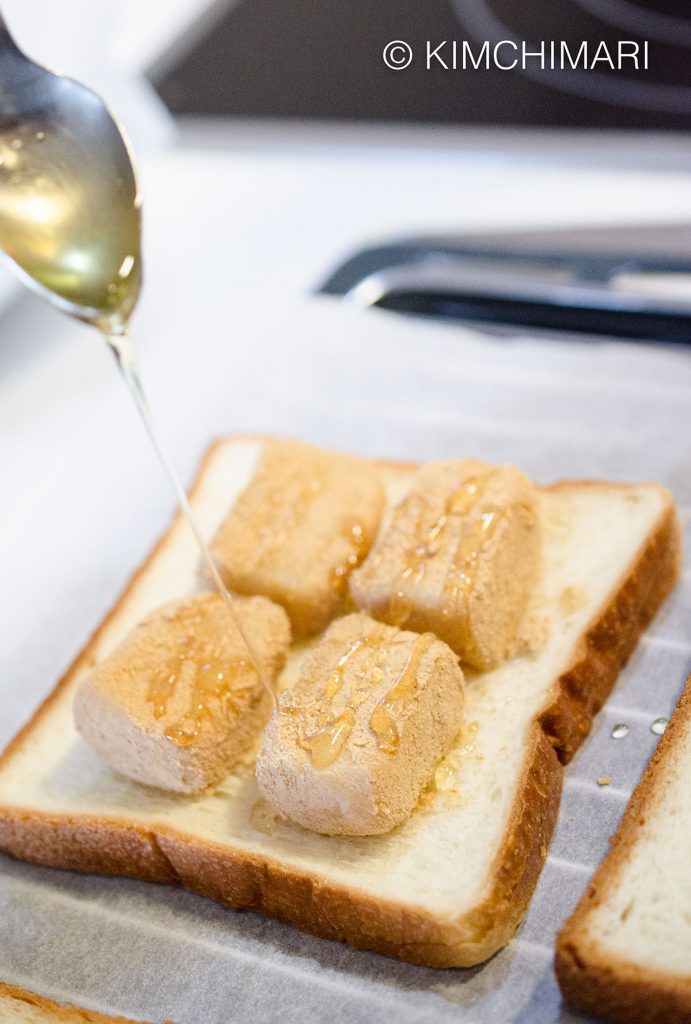
And if you want to try other rice cakes using the same sweet rice flour, here are a couple of other recipes that you can try!
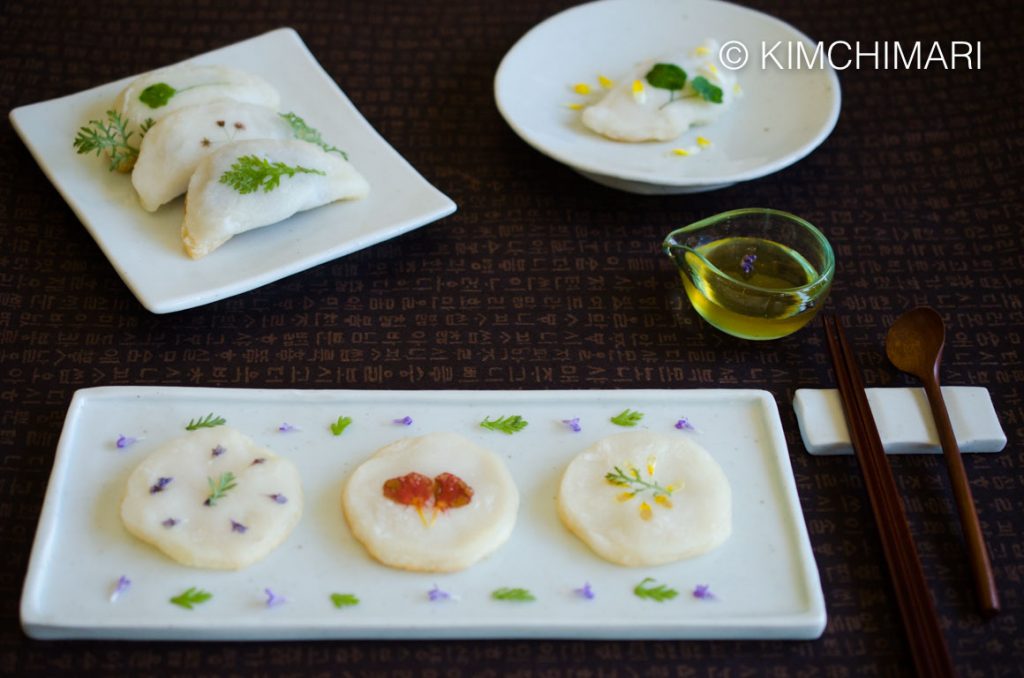
The top left one is called Bukkumi and it’s a sweet dumpling stuffed with Sweet Red Bean paste. The bottom ones are called Hwajeon and it’s the most simplest little mini sweet rice pancake topped with fresh flowers or greens.
Or you can also make my Oven Baked Rice Cake which is also called Tteokppang – it’s a tteok and it’s a cake!
Watch How to Video
☆ Did you make this recipe? I hope you can give me a 5 star rating below!
You can also FOLLOW ME on YouTube, FACEBOOK, PINTEREST and INSTAGRAM or join my FACEBOOK GROUP to see, ask and share everything about Korean food with others just like you!
Enjoy! ❤️,
XOXO
JinJoo
Injeolmi (Korean Sweet Rice Cake)
Ingredients
- 2 cups sweet rice flour (Mochiko Flour) 2 cups = 300g
- 2 Tbsp sugar
- 1 tsp salt
- 1.25 cup water (310 ml)
Soybean powder coating
- 1/2 cup roasted soybean powder 1/2 cup = 60g, about 2 oz
- 1/2 tsp sugar
- 1/8 tsp salt
Instructions
- On a sheet pan or a brownie pan, coat the bottom of the pan by spreading out the roasted soybean flour with your hands. For the 2 cup rice flour recipe, I spread about 9x8 inch area of my 9x13 brownie pan. So I guess an 8x8 pan will work too. Sprinkle about 1 tsp of sugar and a light sprinkle of salt on top of the soybean flour. Set aside.
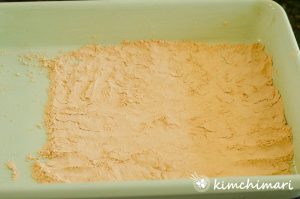
- In a microwavable bowl, add sweet rice flour (aka mochiko flour), salt and sugar. Mix with a whisk.
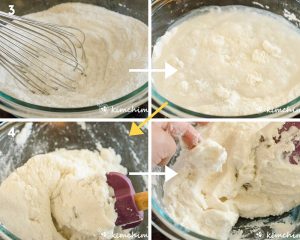
- Add water to flour mixture and mix with a spatula until everything is well blended and no dry flour exists. Be sure to scrape the bottom of the bowl to mix in all the flour. Even out the top with a spatula and cover with a plastic wrap.
- Put the covered bowl in the microwave and cook on HIGH for 2 minutes. Take out the bowl, remove the wrap (be careful of the hot steam as you uncover). You will see that only the top inch layer or so is cooked. Using a spatula, mix it so the top layer goes to the bottom and the uncooked mixture comes to the top. Cover with a wrap once again.
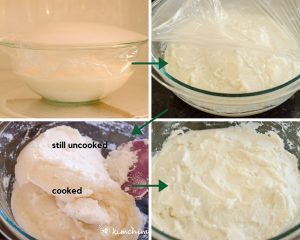
- Microwave HIGH for 2 minutes again. Uncover, mix and cover with wrap one last time.
- Now, microwave HIGH for just 1 minute. Uncover and this time, dip the spatula in cold water and mix a couple of times. Repeat 2-3 times. This helps the rice cake not stick to the spatula too much and also cools down the tteok a little bit while adding additional moisture. Alternatively, you can use a stand mixer to kind of knead the dough. Do it for 1-2 minutes and sprinkle about 1/2 to 1 Tbs of water while you knead it.
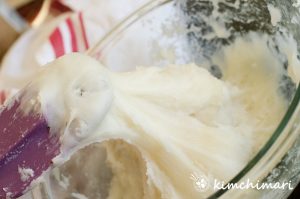
- Have the soybean flour sheet pan and bowl of cold water ready. Put disposable plastic gloves on. The plastic gloves are not a must but it just makes things easier (not have your hand all covered in tteok). Form the Injeolmi rice cake into one ball using a spatula (because it will still be too hot for your hands) and transfer it over to the center of the sheet pan. Now, wet your plastic gloves with cold water and quickly press down the rice cake to spread it out. Repeat wetting your gloves if you feel it's too hot or it's sticking. Press and spread until it covers most of the soybean powder area or until you get your desired thickness.
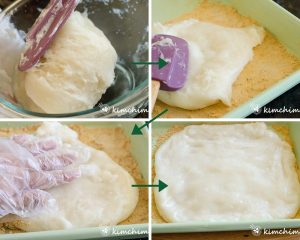
- Cover the top with more soybean powder. Using scissors, cut it into long strips and then each strip into smaller squares or rectangles. For each cut piece, cover the cut sides with soybean flour so it's fully covered all around. The soybean powder prevents Injeolmi from drying out.
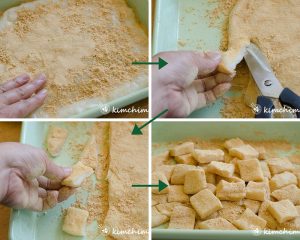
- Enjoy with some lovely tea and honey for dipping!
Equipment
- Microwave
- Microwavable Bowl (Glass Bowl)
- Spatula
- Sheet pan or Brownie Pan
- Scissors
Tips & Notes:
- Follow the steps in order and closely – tteok dries up pretty quickly so you have only a narrow window of time to coat and cut.
- Storage – Store at cool room temperature, tightly covered for up to 12 hrs or less. Best to freeze in airtight container or bag to maintain freshness.
- Reheating/Thawing – Thaw at room temperature. Reheat in a non-stick pan at medium-low heat for couple minutes on each side. For softer and moist results, sprinkle some water when pan is hot (with rice cake in it) and cover with a lid for a couple minutes. You can also leave it in a warm rice cooker for a few minutes. My least favorite option is to reheat in the microwave – a lot of times, it will reheat unevenly and tteok will become really hard once it cools so use the microwave if you know that you will eat it all.
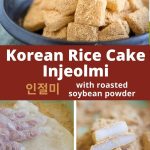


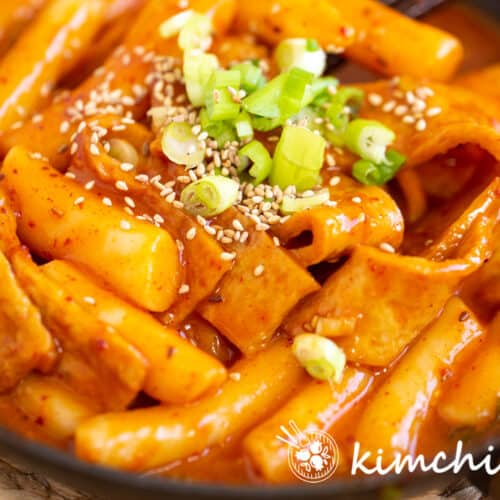
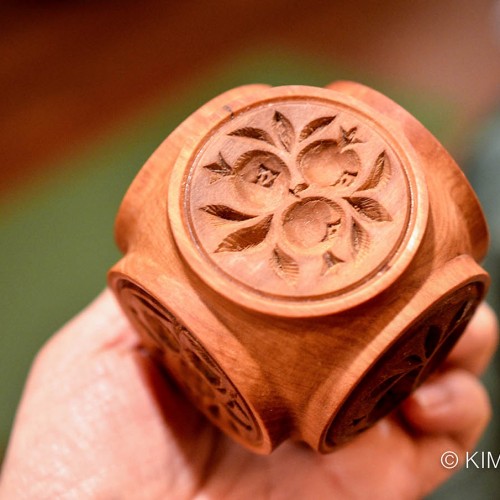
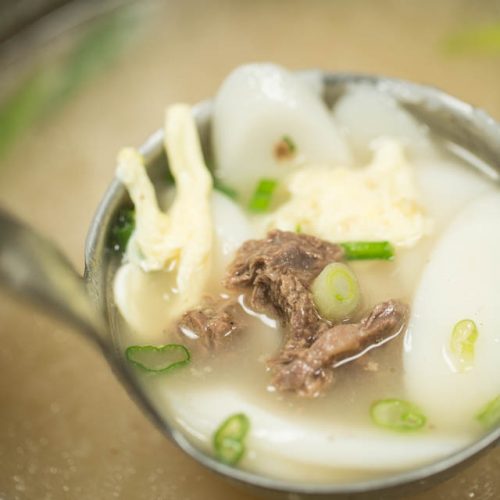
















This looks so good! Can you use misugaru instead of the soybean powder?
Sure, I don’t see why not!
What if you don’t have a microwave?
If you don’t have a microwave, you can try just steaming the mixture.
hi, i would like to try this recipe but i only found whole soybeans and not soybean powder, i read that you wrote that we can make it at home, but i was wondering how i should create the soybeans before toasting and blending them. thank you very much
Hi Alice, thanks for asking. You can rinse the soybeans, dry it and then roast it in evenly in a frying pan until they are fully cooked and lightly brown. And then they make powder of the roasted soybeans. You will probably need a dry blender to make the powder. Hope that helps. Good luck!
I love this recipe. Although I haven’t tried it yet, reading it feels just like my own method. Instead of a bowl, I use a plate or a glass pan to spread an even layer of the rice flour mixture, then cover it with plastic wrap and microwave in 30-second increments. The dough turns out amazing and perfectly cooked after the residual heat does its job. I make two layers and fill mine with sweet red bean paste. I came across this recipe while searching for soybean powder to use as a topping. Fantastic recipe!
Awesome! Love hearing that. I love sweet red bean paste with my injeolmi – making a 2 layer one sounds really yummy. Thanks for sharing!
Hi i want to ask can i put injeolmi in the fridge and eat it without reheating it? And can i put it inside a cake without changing the texture?
Hi Fani, injeolmi will become hard in the fridge. You will need to reheat it before you eat. I’m not sure exactly what you are thinking of by putting it inside a cake. If you are thinking of baking a cake with injeolmi inside, it will melt in the oven..